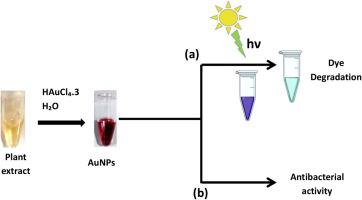Journal of Photochemistry and Photobiology A: Chemistry ( IF 4.1 ) Pub Date : 2020-06-20 , DOI: 10.1016/j.jphotochem.2020.112704 Rohit Kumar Singh , Saroj Sekhar Behera , Khushboo Rani Singh , Sourav Mishra , Bijayananda Panigrahi , Tapas Ranjan Sahoo , Pankaj Kumar Parhi , Dindyal Mandal

|
Herein, polyphenol stabilized gold nanoparticles (AuNPs) have been synthesized for selective removal of cationic dyes from aqueous solution. Gold nanoparticles have been synthesized using Cassytha filiformis plant extract and characterized by UV–vis spectroscopy (UV–vis), High-Resolution Transmission Electron Microscopy (HR-TEM) and X-ray diffraction (XRD). The size of AuNPs was found to be in the range of 8–20 nm with an average size of 12 nm. The newly generated AuNPs demonstrate excellent potential in removing cationic dye such as methylene blue (MB) via photocatalytic degradation under sunlight. The adsorption/degradation behaviour of cationic MB on AuNPs adsorbent from the aqueous solution was studied by varying parameters such as pH and different light sources. Alkaline pH and sunlight were found to be crucial in dye degradation. The adoption of the ultrasonic waves (UW) leads to reduce sorption time significantly with an increase in the sorption ability and at the optimum condition. The AuNPs appear to be promising with a maximum dye loading capacity of 595.23 mg/g and dye degradation efficiency was found to be 87 % after 20 min. Additionally, the antimicrobial studies confirm the significant inhibition (zone of inhibition: 20 mm) of growth of Mycobacterium smegmatis, a model organism for Mycobacterium tuberculosis, suggesting the advancement of a novel new generation eco-friendly and cost-effective ‘green’ AuNPs.
中文翻译:

生物合成的金纳米颗粒作为光催化剂,用于阳离子染料的选择性降解及其抗菌活性
在本文中,已经合成了多酚稳定的金纳米颗粒(AuNPs),用于从水溶液中选择性去除阳离子染料。金丝纳米颗粒已经使用丝状拟南芥合成植物提取物,并通过紫外可见光谱(UV-vis),高分辨率透射电子显微镜(HR-TEM)和X射线衍射(XRD)进行表征。发现AuNP的大小在8–20 nm范围内,平均大小为12 nm。新生成的AuNPs在阳光下通过光催化降解具有优异的潜力,可去除亚甲基蓝(MB)等阳离子染料。通过改变pH和不同光源等参数研究了阳离子MB在AuNPs吸附剂上的吸附/降解行为。发现碱性pH和日光对于染料降解至关重要。在最佳条件下,采用超声波(UW)可以显着减少吸附时间,同时提高吸附能力。AuNPs看起来很有希望,其最大染料负载量为595.23 mg / g,并且在20分钟后发现染料降解效率为87%。此外,抗微生物研究还证实了其生长的显着抑制作用(抑制区域:20毫米)。耻垢分枝杆菌(Mycobacterium smegmatis)是结核分枝杆菌的典范生物,它表明了新一代的新型生态友好型和具有成本效益的“绿色” AuNP。











































 京公网安备 11010802027423号
京公网安备 11010802027423号